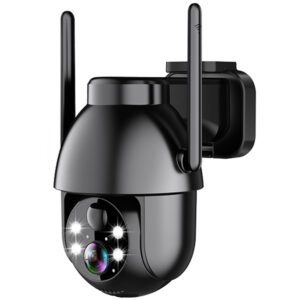When it comes to protecting your property, not all security cameras are created equal. Outdoor PTZ cameras (Pan-Tilt-Zoom) and regular fixed security cameras dominate the market, but they cater to vastly different needs. Whether you’re securing a sprawling backyard, a small business, or a suburban home, understanding their differences is critical. In this guide, we’ll break down how Outdoor PTZ cameras outperform regular models in coverage, flexibility, and advanced features—and when a basic fixed camera might be enough.
What is an Outdoor PTZ Camera?
An Outdoor PTZ camera is a high-tech surveillance system designed to pan (rotate horizontally), tilt (move vertically), and zoom in on specific areas—all remotely. These cameras are ideal for large spaces like driveways, warehouses, or farms, where 360° coverage matters. Key features include:
- Motorized movement: Control the camera’s direction via apps or software.
- Optical zoom: Focus on details like license plates or faces from afar.
- Preset patrol routes: Automatically scan predefined areas.
Popular brands like Hikvision and Reolink offer PTZ models with night vision, weatherproofing, and AI-powered motion tracking.
What is a Regular Security Camera?
A regular security camera (or fixed camera) has a stationary lens that monitors a fixed field of view. These are cheaper, simpler to install, and work well for small areas like front doors, garages, or indoor spaces. Common types include:
- Bullet cameras: Long, cylindrical designs for outdoor use.
- Dome cameras: Discreet, ceiling-mounted indoor/outdoor options.
- Wireless cameras: Battery-powered models like Ring or Arlo.
While reliable, they lack the dynamic capabilities of PTZ camera systems.
Key Differences: Outdoor PTZ Camera vs Regular Security Cameras
1. Coverage Flexibility
- Outdoor PTZ Camera:
- Covers up to 360° horizontally and 90° vertically.
- Track moving objects (e.g., intruders, wildlife) in real time.
- Example: A single PTZ camera can monitor an entire parking lot.
- Regular Camera:
- Fixed to a 60°–110° field of view.
- Requires multiple cameras for large areas.
Verdict: PTZ cameras reduce blind spots and hardware costs for expansive properties.
2. Zoom and Detail Clarity
- Outdoor PTZ Camera:
- Offers optical zoom (up to 30x) for crisp details without pixelation.
- Digital zoom enhances close-ups further.
- Regular Camera:
- Limited to digital zoom, which degrades image quality.
- Struggles to capture details beyond 50 feet.
Verdict: PTZ cameras excel in identifying faces, license plates, or suspicious activity at a distance.
3. Night Vision Performance
- Outdoor PTZ Camera:
- Advanced infrared (IR) or color night vision (e.g., Starlight sensors).
- Range: Up to 300 feet in pitch darkness.
- Regular Camera:
- Basic IR night vision (typically 100–150 feet).
- Grainy footage in low-light conditions.
Verdict: PTZ cameras are superior for 24/7 surveillance in rural or low-light areas.
4. Weather Resistance
- Outdoor PTZ Camera:
- Built to withstand extreme conditions (IP66/IP67 ratings).
- Operates in -40°F to 140°F temperatures (e.g., Axis Communications models).
- Regular Camera:
- Most have IP65/IP66 ratings—durable but less robust than PTZ.
- May fail in heavy snow or hurricanes.
Verdict: PTZ cameras are better for harsh climates like Alaska or Arizona.
5. Cost and Installation
- Outdoor PTZ Camera:
- Price: 200–1,000+ (professional-grade models cost more).
- Installation: Requires wiring, power sources, and mounting brackets.
- Regular Camera:
- Price: 50–300 (budget-friendly).
- Installation: DIY-friendly, often wireless or plug-and-play.
Verdict: Regular cameras win for affordability and simplicity, but PTZ offers long-term value for large properties.
Pros and Cons Summary
| Feature | Outdoor PTZ Camera | Regular Security Camera |
|---|---|---|
| Coverage | 360° pan-tilt-zoom | Fixed field of view |
| Zoom | Optical + digital (30x+) | Digital only (lower quality) |
| Night Vision | Up to 300 ft (color/IR) | Up to 150 ft (IR only) |
| Weatherproofing | IP66/IP67 (extreme conditions) | IP65/IP66 (moderate weather) |
| Best For | Large properties, businesses | Homes, small spaces |
| Cost | $$$ | $ |
Which Should You Choose?
Go with an Outdoor PTZ Camera if:
- You need to monitor a large area (e.g., ranch, parking lot).
- You want to track moving objects or zoom in on details.
- Your region faces extreme weather (heavy snow, storms).
Choose a Regular Security Camera if:
- You’re securing a small home, apartment, or indoor space.
- You’re on a tight budget.
- You prefer easy DIY installation.
Top Brands to Consider
- PTZ Cameras: Hikvision (DS-2DE5425IW-AE), Reolink RLC-823A, Axis Q6155-E.
- Regular Cameras: Ring Spotlight Cam, Arlo Pro 4, Google Nest Cam.
Final Thoughts: Invest in the Right System
Outdoor PTZ cameras are the undisputed champions of large-scale surveillance, offering unmatched coverage, zoom, and durability. However, regular security cameras remain a practical choice for everyday home protection. Assess your property size, budget, and security needs—then pick the system that fits.



